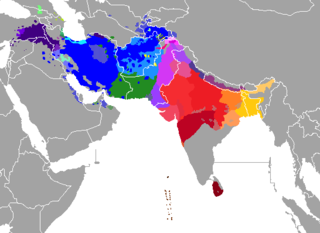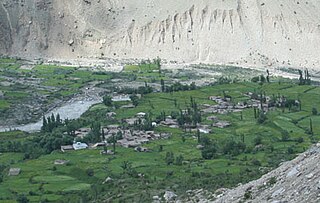
The Indo-Iranian languages constitute the largest and southeasternmost extant branch of the Indo-European language family. They include over 300 languages, spoken by around 1.5 billion speakers, predominantly in South Asia, West Asia and parts of Central Asia.

The Indo-Aryan languages are a branch of the Indo-Iranian languages in the Indo-European language family. As of the early 21st century, they have more than 800 million speakers, primarily concentrated in India, Pakistan, Sri Lanka, Bangladesh, Nepal and Maldives. Moreover, apart from the Indian subcontinent, large immigrant and expatriate Indo-Aryan–speaking communities live in Northwestern Europe, Western Asia, North America, the Caribbean, Southeast Africa, Polynesia and Australia, along with several million speakers of Romani languages primarily concentrated in Southeastern Europe. There are over 200 known Indo-Aryan languages.

The Nuristani languages, also known as Kafiri languages, are one of the three groups within the Indo-Iranian language family, alongside the much larger Indo-Aryan and Iranian groups. They have approximately 130,000 speakers primarily in eastern Afghanistan and a few adjacent valleys in Khyber Pakhtunkhwa's Chitral District, Pakistan. The region inhabited by the Nuristanis is located in the southern Hindu Kush mountains, and is drained by the Alingar River in the west, the Pech River in the center, and the Landai Sin and Kunar rivers in the east. More broadly, the Nuristan region is located at the northern intersection of the Indian subcontinent and the Iranian plateau. The languages were previously often grouped with Indo-Aryan or Iranian until they were finally classified as forming a third branch in Indo-Iranian.

The Dardic languages, or Hindu-Kush Indo-Aryan languages, are a group of several Indo-Aryan languages spoken in northern Pakistan, northwestern India and parts of northeastern Afghanistan. This region has sometimes been referred to as Dardistan.
The Katir are a Nuristani tribe in Afghanistan and Pakistan.

Khowar, or Chitrali, is a Dardic language of Indo-Aryan language family primarily spoken in Chitral and surrounding areas in Pakistan.

Dameli (دَميلي), also Damia, Damiabaasha or Gidoj, is an Indo-Aryan language of the Dardic subgroup spoken by approximately 5,000 people in the Domel Town, in the Chitral District of Khyber-Pakhtunkhwa province of Pakistan.

Kalasha is an Indo-Aryan language spoken by the Kalash people, in the Chitral District of Khyber Pakhtunkhwa province of Pakistan. There are an estimated 4,100 speakers of Kalasha. It is an endangered language and there is an ongoing language shift to Khowar.

Palula and also known as Ashreti (Aćharêtâʹ) or Dangarikwar, is an Indo-Aryan language spoken by approximately 10,000 people in the valleys of Ashret and Biori, as well as in the village of Puri in the Shishi valley and at least by a portion of the population in the village Kalkatak, in the Chitral District of Khyber Pakhtunkhwa province of Pakistan.

The Yidgha language is an Eastern Iranian language of the Pamir group spoken in the upper Lotkoh Valley of Chitral in the Khyber Pakhtunkhwa province of Pakistan. Yidgha is similar to the Munji language spoken on the Afghan side of the border.

The Munji language, also known as Munjani (مونجانی), Munjhan (مونجهان), and the Munjiwar language, is a Pamir language spoken in the Munjan valley in the Kuran wa Munjan district of the Badakhshan province in northeast Afghanistan. It is similar to the Yidgha language, which is spoken in the Upper Lotkoh Valley of Chitral, west of Garam Chashma in Khyber Pakhtunkhwa, Pakistan.
Gawri (ګاوری), also known as Kalami (کالامي), or Bashkarik, is an Indo-Aryan language spoken in Swat Kohistan region in the upper Swat District and in the upper Panjkora river valley of Upper Dir District, Khyber Pakhtunkhwa, Pakistan.
Wasi-wari is the language of the Wasi people, spoken in a few villages in the Pārūn Valley in Afghanistan. It also goes by the name Prasun or Pārūni.

Shumashti – also known as Shumasht – is an Indo-Aryan language spoken in eastern Afghanistan. It is spoken in parts of Kunar Province: on the western side of the Kunar Valley between Jalalabad and the Pech Valley. The number of speakers was estimated at 1,000 in 1994.
Tirahi are Indo-Aryan people who are native and original inhabitants of Tirah valley. They are closely related to their Dardic neighbours and speak Tirahi language, a nearly extinct if not already extinct Indo-Aryan language which may still be spoken by older adults, who are likewise fluent in Pashto, in a few villages in the southeast of Jalalabad in Nangarhar Province, Afghanistan. They were the previous inhabitants of Tirah and the Peshawar Valley in modern-day Khyber Pakhtunkhwa, Pakistan.
Sawi, Savi, or Sauji, is an endangered Indo-Aryan language spoken in northeastern Afghanistan and north-western Pakistan. It is classified as a member of the Shina language cluster within the Dardic subgroup.

The Kalasha, or Kalash, are an Indo-Aryan indigenous people residing in the Chitral District of the Khyber-Pakhtunkhwa province of Pakistan.
Tirahi is a nearly extinct if not already extinct Indo-Aryan language spoken in a few villages in the southeast of Jalalabad in the Nangarhar Province of eastern Afghanistan. It is spoken by older adults, who are likewise fluent in Pashto.
The Yidgha-Munji people also known as Mukhbani are the Iranian-Pamiri peoples inhabiting the Lotkoh Valley in Chitral and Kuran wa Munjan District in Badakhshan in both Pakistan and Afghanistan.

Arandu (ارندو), is a town in the Lower Chitral District of Khyber Pakhtunkhwa, Pakistan, on the banks of the Landai Sin River just above its confluence with the Kunar River. Arandu lies on the border with Kunar Province, Afghanistan.













